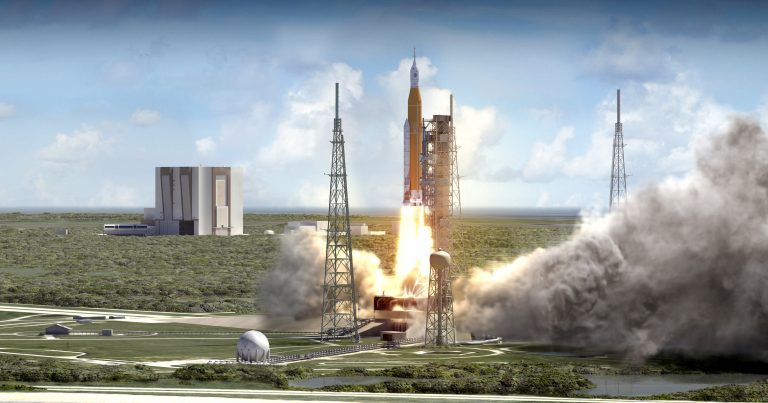
Feb 22, 2018
Like a “Spinal Tap” guitarist, NASA turned the dial up to 11 today on a souped-up rocket engine from the bygone space shuttle program.
The 260-second engine firing at Stennis Space Center in Mississippi represented the toughest test yet for hardware that’s destined to go on the Space Launch System, NASA’s heavy-lift rocket.
NASA plans to use sets of Aerojet Rocketdyne RS-25 rocket engines left over from the shuttle program in the main propulsion systems on the first four SLS rockets, four at a time. Fourteen of the 16 hydrogen-fueled engines were previously installed on the shuttle orbiters, which were retired in 2011 and are now on display in museums.
The recycled RS-25s have been upgraded with new seals as well as 3-D printed parts that are designed to serve as shock absorbers during the engines’ thunderous firings.
Stennis’ test firings are aimed at certifying that the upgrades work as planned, and that the engines can perform at the higher power ratings required by the SLS. Today’s test hit 113 percent of the engine’s original design thrust level, the highest mark ever achieved.
Computer modeling already had determined that the engines can reach those levels, but today’s test provided valuable ground truth — and will guide Aerojet Rocketdyne as it makes more RS-25s.
“Increased thrust requirements for the RS-25 are just one of the many changes in the SLS rocket’s performance that will facilitate our nation’s deep-space exploration goals and objectives,” Dan Adamski, RS-25 program director at Aerojet Rocketdyne, said in a news release.
The first SLS flight, known as Exploration Mission 1, aims to send an uncrewed Orion capsule to the far side of the moon and back in 2020. Astronauts are due to get on board for a similar round-the-moon odyssey in 2023.
The SLS has been controversial because of its estimated $10 billion development cost, its operational cost of roughly $1 billion per launch, and a relatively low projected flight rate of one to two launches per year.
In comparison, SpaceX CEO Elon Musk estimates the cost of creating his company’s Falcon Heavy rocket at upwards of $500 million. The list price for a Falcon Heavy launch is $90 million.
SpaceX’s Falcon Heavy, which made its debut this month, is currently the world’s most powerful rocket in operation with 5 million pounds of liftoff thrust. But the SLS is designed to exceed that performance.
The initial version, known as SLS Block 1, aims to deliver 8.8 million pounds of liftoff thrust — more than the 7.5 million pounds that the Saturn V rocket mustered for Apollo moon shots. SLS Block 2 would turn the dial even higher, to 9.2 million pounds.
In terms of payload lift capacity, Block 1 could put 70 metric tons in low Earth orbit, and Block 2 takes that figure up to 143 tons. Falcon Heavy’s comparable lift capacity is 64 metric tons.
NASA intends to use the SLS for missions to the moon, Mars and other deep-space destinations. But the rocket’s critics say other heavy-lift launch vehicles such as the Falcon Heavy or Blue Origin’s yet-to-be-built New Glenn could be configured to do what needs to be done less expensively and more frequently.
Agency










